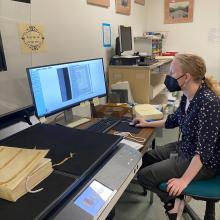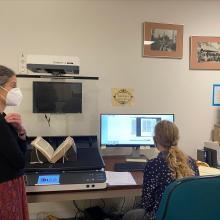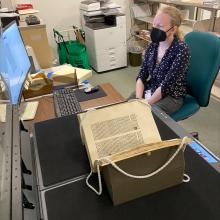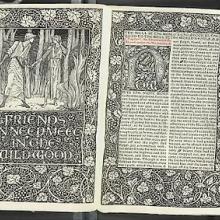Did you know that French & Italian Studies is home to the Textual Studies Program? In 2021, the Textual Studies Program (TXTDS) launched a new undergraduate minor in Textual Studies & Digital Humanities. Students can explore how texts — from scrolls, manuscripts, and printed books to archival documents, digital texts, and textual data — have been written, published, read, circulated, and archived from antiquity to today. Courses include hands-on work with historical texts, archival sources, and contemporary artists’ books, as well as with methods for editing, digitizing, exhibiting, and publishing texts. Students also gain experience building and analyzing text-oriented databases and archives. The minor will be of interest to students thinking about further studies or careers in editing and publishing, libraries and library science, archives and cultural institutions, and in contexts that involve working with cultural and literary texts in digital and/or archival environments. For more information, see the Textual Studies Program website, reach out to text@uw.edu, and/or talk to your advisor!
This guest post is written by Linguistics, French, and TXTDS student Piper Thomas, who recently completed the Textual Studies and Digital Humanities (TXTDS) minor Capstone project. This story has also been posted to the Textual Studies website. Photos by Assistant Book Arts Librarian Kat Lewis.
About Me
I am majoring in Linguistics, and minoring in French Language, Literature, and Culture as well as Textual Studies and Digital Humanities. I have always been interested in how people choose to present and preserve information, and seeing evidence of people in the past simply being people never fails to make me smile. When presented with the opportunity to explore the vast collection of handmade records of individual experiences housed in the Special Collections, I knew I had to take it. I adore seeing how the technology of writing has developed throughout human history, and how people during every era used the existing technology in creative ways.
Capstone Project
For my capstone project in Textual Studies, I began with an annotated bibliography. It served to give me some background for who William Morris was and what he did - since that was to be the focus of my project. In addition, it was very helpful to me as an undergraduate student, because it was a chance to learn how to do research. It was very nice to go through the process of research while having a guiding hand there to provide feedback, and without the pressure of having to get it right on the first try.
After doing the annotated bibliography, we decided that it would be good for me to create an online exhibit about some of the things I had noticed. Unlike the annotated bibliography, the subject of the exhibit was largely left to my discretion so long as it was at least somewhat related to William Morris. I felt that it would be cool to compare some Morris books to books by modern book artists. After doing some further exploration, I decided to compare the usage of white space in three different books, one of which was by Morris.
It was honestly a wonderful experience. I was given freedom to follow whatever route piqued my interest, with a huge amount of resources available to me, and great support available when I ran into hurdles. I learned a lot about how to navigate the library and interact with delicate books, how to find resources for research, and how to create an online paper.
Online Exhibit: Whitespace in Illustrations and Book Arts



